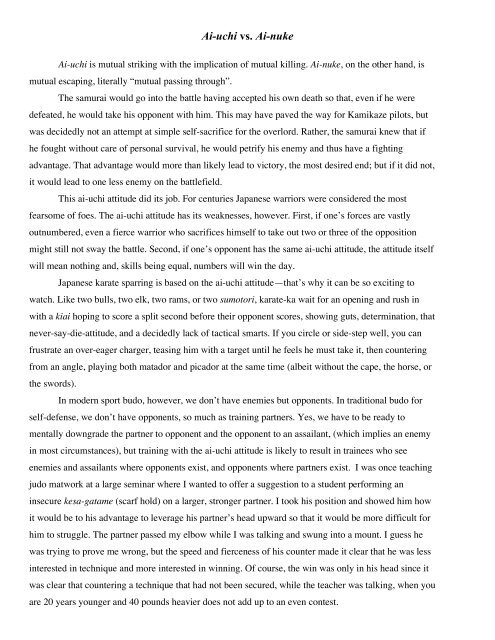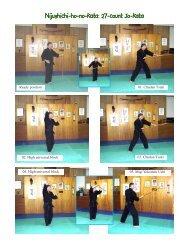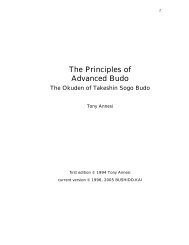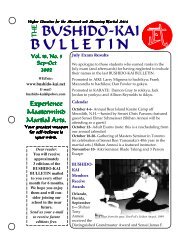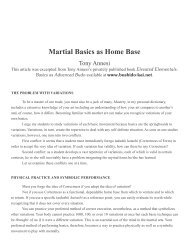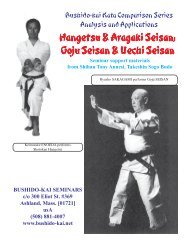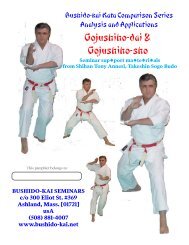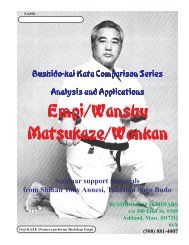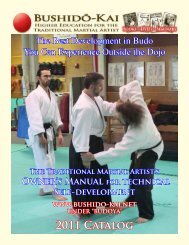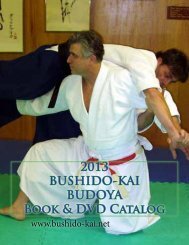Ai-uchi vs. Ai-nuke - Bushido-Kai
Ai-uchi vs. Ai-nuke - Bushido-Kai
Ai-uchi vs. Ai-nuke - Bushido-Kai
You also want an ePaper? Increase the reach of your titles
YUMPU automatically turns print PDFs into web optimized ePapers that Google loves.
<strong>Ai</strong>-<strong>uchi</strong> <strong>vs</strong>. <strong>Ai</strong>-<strong>nuke</strong><br />
<strong>Ai</strong>-<strong>uchi</strong> is mutual striking with the implication of mutual killing. <strong>Ai</strong>-<strong>nuke</strong>, on the other hand, is<br />
mutual escaping, literally “mutual passing through”.<br />
The samurai would go into the battle having accepted his own death so that, even if he were<br />
defeated, he would take his opponent with him. This may have paved the way for Kamikaze pilots, but<br />
was decidedly not an attempt at simple self-sacrifice for the overlord. Rather, the samurai knew that if<br />
he fought without care of personal survival, he would petrify his enemy and thus have a fighting<br />
advantage. That advantage would more than likely lead to victory, the most desired end; but if it did not,<br />
it would lead to one less enemy on the battlefield.<br />
This ai-<strong>uchi</strong> attitude did its job. For centuries Japanese warriors were considered the most<br />
fearsome of foes. The ai-<strong>uchi</strong> attitude has its weaknesses, however. First, if one’s forces are vastly<br />
outnumbered, even a fierce warrior who sacrifices himself to take out two or three of the opposition<br />
might still not sway the battle. Second, if one’s opponent has the same ai-<strong>uchi</strong> attitude, the attitude itself<br />
will mean nothing and, skills being equal, numbers will win the day.<br />
Japanese karate sparring is based on the ai-<strong>uchi</strong> attitude—that’s why it can be so exciting to<br />
watch. Like two bulls, two elk, two rams, or two sumotori, karate-ka wait for an opening and rush in<br />
with a kiai hoping to score a split second before their opponent scores, showing guts, determination, that<br />
never-say-die-attitude, and a decidedly lack of tactical smarts. If you circle or side-step well, you can<br />
frustrate an over-eager charger, teasing him with a target until he feels he must take it, then countering<br />
from an angle, playing both matador and picador at the same time (albeit without the cape, the horse, or<br />
the swords).<br />
In modern sport budo, however, we don’t have enemies but opponents. In traditional budo for<br />
self-defense, we don’t have opponents, so much as training partners. Yes, we have to be ready to<br />
mentally downgrade the partner to opponent and the opponent to an assailant, (which implies an enemy<br />
in most circumstances), but training with the ai-<strong>uchi</strong> attitude is likely to result in trainees who see<br />
enemies and assailants where opponents exist, and opponents where partners exist. I was once teaching<br />
judo matwork at a large seminar where I wanted to offer a suggestion to a student performing an<br />
insecure kesa-gatame (scarf hold) on a larger, stronger partner. I took his position and showed him how<br />
it would be to his advantage to leverage his partner’s head upward so that it would be more difficult for<br />
him to struggle. The partner passed my elbow while I was talking and swung into a mount. I guess he<br />
was trying to prove me wrong, but the speed and fierceness of his counter made it clear that he was less<br />
interested in technique and more interested in winning. Of course, the win was only in his head since it<br />
was clear that countering a technique that had not been secured, while the teacher was talking, when you<br />
are 20 years younger and 40 pounds heavier does not add up to an even contest.
Testing a technique is not only reasonable but also desirable. Testing it while gradually<br />
increasing the skill and size of the opposition is also reasonable and desirable. Switching to a battlefield<br />
attitude is, to say the least, inappropriate. Testing doesn’t happen during teaching; it happens after<br />
teaching, after studying, and during a simulated battle. To many students (probably some of these are in<br />
your own dojo), there are only two gears: ai-<strong>nuke</strong> (letting one’s opposite number pass through) or ai<strong>uchi</strong><br />
(fighting as if you were on a medieval Japanese battlefield).<br />
Would the ai-<strong>uchi</strong> enthusiast be wiser to adapt an attitude of ai-<strong>nuke</strong>? Yes and no.<br />
More on <strong>Ai</strong>-<strong>uchi</strong> <strong>vs</strong>. <strong>Ai</strong>-<strong>nuke</strong> next week.


